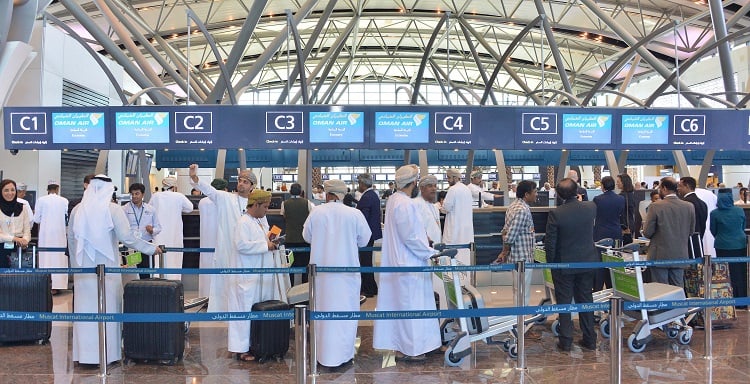The new Muscat International Airport, ranked among the top 10 airports in the Middle East, showcases how the aviation industry is winging its way forward across new horizons
Omani airports have achieved a robust growth in both passenger traffic and flight movement last year, which were in line with the three-pronged aviation strategy of the government. Reflecting the trend, the number of passengers at Muscat International Airport exceeded 14 million in 2017, a robust growth of 17 per cent over the previous year. Similarly, Salalah International Airport also broke its record with a 24 per cent growth at 1.5 million passengers as a result of an increase in both domestic and international travel. Additionally, flight movements increased to double digits in Muscat International Airport at 11 per cent exceeding 114,000 movement, while Salalah International Airport had 14,381 flight movement.
Transit passengers at Muscat International Airport increased by 33 per cent, exceeding 6.44 million passengers that strengthened the airport’s hub strategy. The biggest markets to and from Oman are GCC countries representing 35 per cent, Indian subcontinent 35 per cent and Europe by nearly 10 per cent.
In addition to Oman Air’s rapid growth especially in transit passengers, major foreign carriers showed positive growth numbers. Qatar Airways added frequencies to both Muscat and Salalah as well as the airline made a connection with Sohar Airport providing a link to and from Doha. The third airline that connected with Sohar Airport season was Air Arabia.
Freight transport
Freight transport at Muscat International Airport enjoyed positive growth of 24 per cent, where the cargo volumes in 2017 exceeded 200,000 tonnes compared to 162,000 tonnes in 2016. The growth was mainly due to an increase in transfer traffic cargo.
Salalah has a favourable geographic position as the second busiest sea port in the Middle-East and it is expected that by enhanced collaboration with cargo stakeholders to develop sea-air transportation services, airfreight volume will be on growth path in the coming years. In fact, the recent opening of Oman’s most modern Muscat International Airport is expected to further strengthen the growth of aviation sector in the country. The state-of-the-art airport has a capacity to handle 40 flights per hour with 86 check-in counters, 40 gates, and 29 aircraft stands with passenger boarding bridges, as well as a new control tower. Out of ten carousels for bag handling, eight will be used for international flights. The decision to build a new airport was taken after studies found that there could be a 40 per cent growth in number of visitors to Oman by 2019.Planning for the new $1.8-billion airport has spanned almost a decade but the first phase of construction began in December 2014, which included a modern terminal building, a new runway, air traffic control tower and civil aviation building.
New Terminal
The new terminal has a capacity to handle 12 million passengers per annum, which can be scaled up to 24 million, 36 million and 48 million in different phases if needed. The new terminal will have the capacity to handle large aircraft such as the Airbus A380 and the Boeing 747. The existing terminal will be used for low-cost carrier operations.
Presently, the Muscat International Airport is ranked in the top 10 airports in the Middle East, with an average annual growth forecast of 8 per cent.
The government is looking at attracting airlines not only to Muscat, but also for local travel as regional airports need activity and Oman Air alone will not be able to operate all the routes. Among the planned regional airports, Duqm and Sohar airports have started operations and the terminal buildings are progressing well.
The Duqm airport’s modern passenger terminal building, built by Larsen & Toubro, will have a capacity of 500,000 passengers per year. The airport will have a 37 meter high air traffic control tower and an air cargo terminal equipped to handle 25,000 tonnes of cargo per annum. With Qatar Airways launching several services to Sohar recently, the airport activity started picking up. Like the Duqm regional airport, the terminal building (which can handle half-a-million passengers per annum) at Sohar airport is progressing well.
National Carrier
National carrier Oman Air is currently embarking on a fleet and network expansion programme, which will see the airline operate up to 62 aircraft to around 60 destinations by 2022. The airline is committed to constantly improving its product, while undergoing its dynamic fleet and network expansion, developing its brand and offering its guests an unrivalled experience as part of its mission to become the best. Oman Air plans to launch three new routes this year to Istanbul (Turkey) in June, Casablanca (Morocco) in July, and Moscow (Russia) in October. The new routes will also enable Oman Air’s passengers to explore three of the world’s most exciting cities. Besides, there are plans to expand routes to Indian cities from Muscat. Oman Air first launched flights to India in the 1990s and the demand for seats has grown exponentially, among business and leisure passengers, not only increasing tourism traffic and revenue but also promoting vital trade agreements between the two countries. In 2016, the air services agreement between the governments of Oman and India was revised, when the number of weekly seats was increased by 6,258 seats per week to 27,405 seats for both countries. The national airline is also in talks with planemakers Airbus and Boeing to expand its wide-body fleet to 25 jets. The airline currently has 16 wide-body planes – six Boeing 787 Dreamliners and 10 Airbus A330 – but hope to increase that number to 25. This will involve replacement of some existing Airbus planes, and adding nine more new jets. With the opening of the new airport, Oman Air has enough airport facilities at Muscat and Salalah, which will help it offer additional flights and right connections.
The newly established budget airline – Salam Air – started its operation in 2017, mainly focusing on the domestic sector connecting Salalah and Muscat, as well as international routes to the UAE, Saudi Arabia and Pakistan. Salam Air was also the first airline to enter to Sohar Airport connecting Salalah and Sohar. As per the plan, Salam Air will operate as many as 12 Airbus A320 narrow body jets by 2020, as it aims for profitability by the end of 2018. It plans to increase its fleet to between 10 and 12 A320s by 2020 from the three it has leased from Chile’s LATAM Airlines. Promoted by Muscat National Development and Investment Company (ASAAS), an investment holding firm of Oman government, Salam Air was formed to meet Oman’s rapidly growing demand for air traffic.







